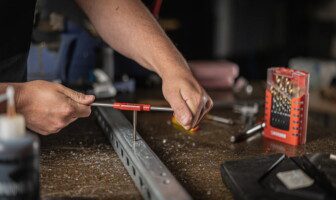
Public restrooms aren’t the cleanest places in the world, nor will they ever be. However, with some intentional planning and design, they can be safer than they currently are. If you’re building or renovating a public restroom in a building you own, it’s important to have a plan.
4 Tips for more Sanitary Public Restrooms
Having public restrooms is, well, better than the alternative of not having a designated place for people. However, they aren’t exactly the cleanest places. In many respects, they can be downright germ-ridden.
When you flush the toilet with the lid up, bacteria can go as high as six feet into the air (high enough to land on the top of your head). You can find traces of over 77,000 different bacteria and viruses in the average public restroom. And here’s a doozy of a statistic: Researchers find traces of E. coli on airplane bathroom door handles nearly 100 percent of the time. Yikes!
In other words, public restrooms can be a mess. And if you’re a business owner, building owner, or landlord, you have a responsibility to do more than just provide the appearance of cleanliness. It actually needs to be clean.
Here are a few tips for designing and maintaining a more sanitary public restroom:
1. Use the Right Building Materials
If you’re building or renovating a public restroom, it’s important that you think about the material selected from the start. Certain materials are far more resistant to germs than others. By installing them, you can make your restroom more sanitary from the beginning.
For example, drywall isn’t always the best choice for bathroom walls. They’re very absorbent and will often retain moisture, bacteria, germs, viruses, mold, and mildew – particularly around wet environments like toilets and sinks.
If not drywall, what do you use? There are a variety of options, but Water proof Wall Paneling is the preferred option. These panels are made from PVC and are lauded for their strength and durability. They’re highly resistant to chemicals, unaffected by moisture, and are warrantied to never mold or rot. Waterproof vinyl panels can also be cleaned relatively easily.
2. Install Touchless and Sustainable Systems
Beginning in the 1980s, touchless technology began to emerge as the go-to option in public restrooms. And over the past several years, the technology has improved to the point that you can realistically use a public restroom without touching anything.
The touchless fixture solutions can be used to easily combine faucets and soap dispensers. The main goal of this combination style is to ensure safety and give an attractive appearance. As people use the same space for handwashing and drying, water spills are limited, which mitigates slip-and-fall conditions.
The same goes for toilets and urinals. By integrating the latest touchless technology, you can cut down on the spread of germs and keep individuals safer and cleaner. (This also reduces the spread of germs and bacteria to hand-washing stations and door handles.)
3. Use the Right Layout
Public restroom layouts should be optimized in such a way that people have plenty of space. This includes spacing between toilets/urinals, as well as spacing between toilets and handwashing stations. A lack of separation can cause germs and bacteria to spread at a faster rate and potentially contaminate surfaces that are meant to be clean.
For high-traffic restrooms where there’s likely to be a line (such as an event venue), designing extra space for proper distancing is a smart idea.
4. Choose the Proper Hand Washing and Drying Features
As many as 30 percent of men and up to 10 percent of women do not wash their hands after using a public restroom. This is clearly unsanitary and poses a risk to public health. One way to address this issue is by installing non-gendered handwashing stations in the middle of the restroom with two-sided entries directing flow to gender-specific restrooms. This basically creates social pressure to wash hands in public view.
Putting it All Together
Public restrooms will never be clean, per se. However, some public restrooms are much cleaner than others. And in most cases, it comes down to choosing the right materials, systems, features, and layout. From Waterproof Vinyl Panels to touchless fixtures, details matter! Is it time to rethink your restroom?
Read Also:






























